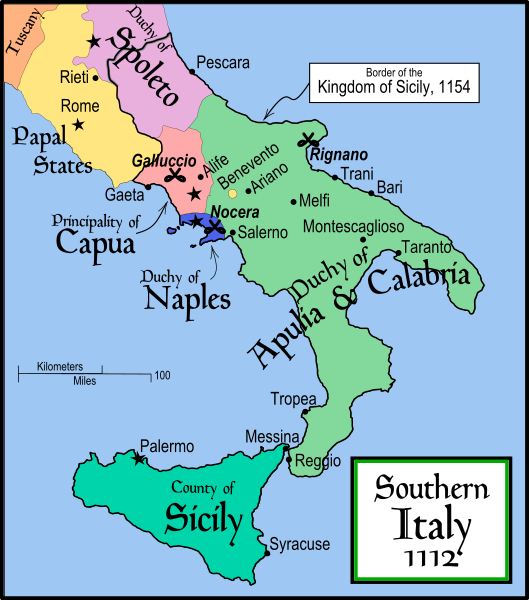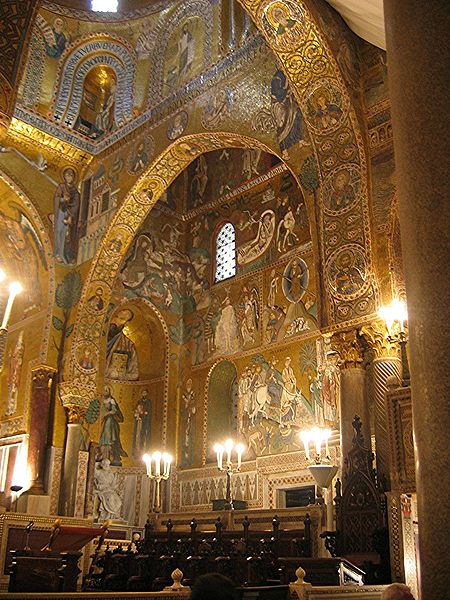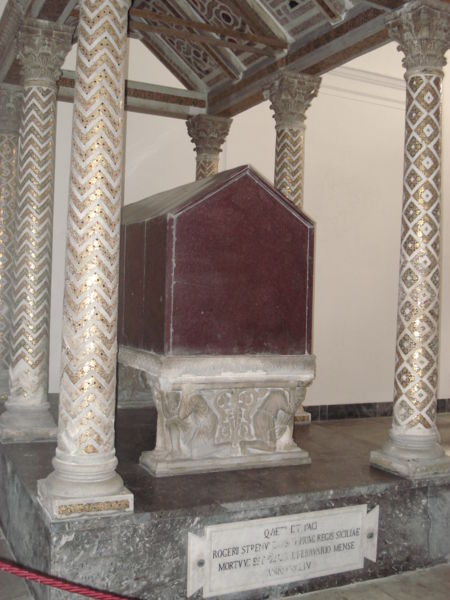<Back to Index>
- Philosopher Cesare Cremonini, 1550
- Sculptor Luca della Robbia, 1400
- King of Sicily Roger II, 1095
PAGE SPONSOR
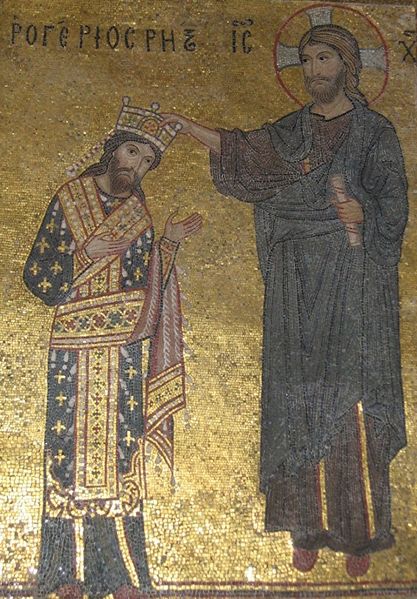
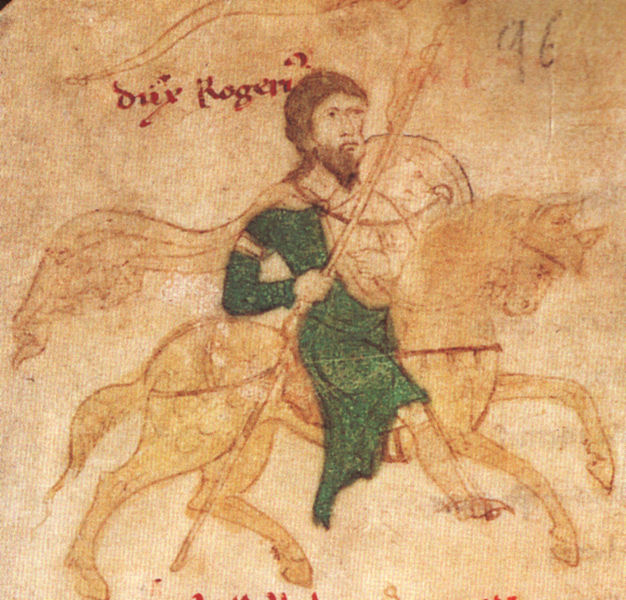
Roger II (22 December 1095 – 26 February 1154) was King of Sicily, son of Roger I of Sicily and successor to his brother Simon. He began his rule as Count of Sicily in 1105, later became Duke of Apulia and Calabria (1127), then King of Sicily (1130). Roger had succeeded in uniting all the Norman conquests in Italy into one kingdom with a strong centralized government.
By 999, Norman adventurers had come to southern Italy. By 1016, they were involved in the complex local politics where Lombards were fighting against the Saracens pirates or the Byzantine Empire. These mercenaries fought the enemies of the Italian city-states, but in the following century they gradually became the rulers of the major polities south of Rome.
At the time of the birth of his youngest son, in 1095, Roger I ruled the County of Sicily, his nephew, Roger Borsa, was the Duke of Apulia and Calabria, and his great nephew, Richard II of Capua, was the Prince of Capua. Alongside these three major rulers were a large number of minor counts, who effectively exercised sovereign power in their own localities. These counts at least nominally owed their allegiance to one of these three Norman rulers, but such allegiance was usually weak and often ignored.
When Roger I, Count of Sicily, died in 1101, his young son, Simon of Hauteville, became Count, with his mother Adelaide del Vasto as regent. Simon died four years later in 1105, at the age of 12. Adelaide continued as regent to her younger son Roger, who was just 9 years old. On the death of his elder brother, Simon of Hauteville, in 1105, Roger inherited the County of Sicily under the regency of his mother, Adelaide del Vasto. During this time the mother was assisted by such notables as Christodulus, the emir of Palermo.
In the summer of 1110, he was visited by the Norwegian king Sigurd Jorsalfare on his way to Jerusalem. The story suggests that Sigurd gave him the name King of Sicily, 20 years before he actuall obtained this title.
In 1112, at the age of 16, Roger began his personal rule, being named "now knight, now Count of Sicily and Calabria" in a charter document dated June 12, 1112.
In 1117, his mother, who had married Baldwin I of Jerusalem, returned to Sicily, since the Patriarch of Jerusalem had declared the marraige invalid. Roger seems to have felt the slight, and this might explain his later reluctance to go crusading. Roger married his first wife, Elvira, daughter of Alfonso VI of Castile and his fourth queen, Isabella, who may be identical to his former concubine, the converted Moor, Zaida, baptised Isabella.
In 1122, William II, the Duke of Apulia and Roger's first cousin once removed, offered to renounce his remaining claims to Sicily as well as part of Calabria. Roger, in exchange, crossed the Straits of Messina to subjugate the duke's vassal, Count Jordan of Ariano. In doing so, he penetrated the Basilicata and took Montescaglioso.
When William II of Apulia died childless in July 1127, Roger claimed all Hauteville family possessions in the peninsula as well as the overlordship of the Principality of Capua, which had been nominally given to Apulia almost thirty years earlier. However, the union of Sicily and Apulia was resisted by Pope Honorius II and by the subjects of the duchy itself. The popes had long been suspicious of the growth of Norman power in southern Italy and at Capua in December, the pope preached a crusade against Roger, setting Robert II of Capua and Ranulf II of Alife (his own brother-in-law) against him. After this coalition failed, in August 1128 Honorius invested Roger at Benevento as Duke of Apulia. The baronial resistance, which was backed by Naples, Bari, Salerno, and other cities whose aim was civic freedom, gave way. In September 1129 Roger was generally recognized as duke of Apulia by Sergius VII of Naples, Robert of Capua, and the rest. He began at once to enforce order in the duchy, where the ducal power had long been fading. Upon the death of Pope Honorius in February 1130 there were two claimants to the papal throne. Roger supported Antipope Anacletus II against Innocent II. The reward was a crown, and, on 27 September 1130, Anacletus' papal bull made Roger king of Sicily. He was crowned in Palermo on the Christmas Day 1130. This plunged Roger into a ten year war. The famous Bernard of Clairvaux, Innocent's champion, organized a coalition against Anacletus and his "half - heathen king." He was joined by Louis VI of France, Henry I of England, and the Lothair III, Holy Roman Emperor. Meanwhile southern Italy revolted. In 1130, the Duchy of Amalfi revolted and in 1131, Roger sent John of Palermo across the Strait of Messina to join up with a royal troop from Apulia and Calabria and march on Amalfi by land while George of Antioch blockaded the town by sea and set up a base on Capri. Amalfi soon capitulated. In 1132, Roger sent Robert II of Capua and Ranulf II of Alife to Rome in
a show of force in support of Anacletus. While they were away, Roger's
half - sister Matilda, the wife of Ranulf, fled to Roger claiming
abuse.
Simultaneously, Roger annexed Ranulf's brother's County of Avellino.
Ranulf demanded the restitution of both wife and countship. Both were
denied, and Ranulf left Rome against orders, with Robert following. First Roger dealt with a rebellion in Apulia, where he defeated and deposed Grimoald, Prince of Bari, replacing him with his second son Tancred. Meanwhile, Robert and Ranulf took papal Benevento. Roger went to meet them but was defeated at the Battle of Nocera on 25 July 1132. Roger retreated to Salerno. The
next year, Lothair III came down to Rome for his imperial coronation.
The rebel leaders met with him there, but they were refused help because Lothair's force was too small. With
the emperor's departure, divisions in his opponents' ranks allowed
Roger to reverse his fortunes. By July 1134, Roger's troops had forced
Ranulf, Sergius, and the other ring leaders to submit. Robert was
expelled from Capua and Roger installed his second son, Alfonso of Hauteville, as Prince of Capua. Roger II's eldest son Roger was given the title of Duke of Apulia. Meanwhile, Lothair's contemplated attack upon Roger had gained the backing of Pisa, Genoa, and the Byzantine emperor,
each of whom feared the growth of a powerful Norman kingdom. A Pisan
fleet led by the exiled prince of Capua laid anchor in Naples (1135).
Ranulf joined Robert and Sergius there, encouraged by news coming from
Sicily that Roger was fatally ill or even already dead. The important fortress of Aversa, among others, passed to the rebels, and only Capua resisted under the royal chancellor, Guarin.
On June 5, however, Roger disembarked in Salerno, much to the surprise
of the whole mainland provinces. The royal army, split in several
forces, easily conquered Aversa and even Alife, the base of the natural
rebel leader, Ranulf. Most of the rebels took refuge in Naples, which
was besieged in July, but despite the poor health conditions within the
city, Roger was not able to take it, and returned to Messina late in the year. In 1136, the long-awaited imperial army, led by Lothair and the duke of Bavaria, Henry the Proud,
descended the peninsula to support the three rebels. Henry, Robert, and
Ranulf took a large contingent of troops to besiege the peninsular
capital of the kingdom, Salerno. Roger remained in Sicily, leaving its mainland garrisons helpless under the chancellor Robert of Selby, while even the Byzantine emperor John II Comnenus sent
subsidies to Lothair. Salerno surrendered, and the large army of
Germans and Normans marched to the very south of Apulia. There, in June
1137, Lothair besieged and took Bari. At San Severino,
after the victorious campaign, he and the pope jointly invested Ranulf
as duke of Apulia (August 1137), and the emperor then retired to
Germany. Roger, freed from the utmost danger, immediately disembarked
in Calabria, at Tropea,
with 400 knights and other troops, probably mostly Muslims. After
having been welcomed by the Salernitans, he recovered ground in Campania, sacking Pozzuoli,
Alife, Capua, and Avellino. Sergius, terrified, was forced to
acknowledge him as overlord of Naples and sway his allegiance to
Anacletus: that moment marked the fall of an independent Neapolitan
duchy, and thereafter the ancient city was fully integrated into the
Norman realm. Thence
Roger moved to Benevento and northern Apulia, where Duke Ranulf,
although steadily losing his bases of power, had some German troops
plus some 1,500 knights from the cities of Melfi, Trani, Troia, and Bari, who were "ready to die instead to lead a miserable life." On 30 October 1137, at the Battle of Rignano (next to Monte Gargano),
the younger Roger and his father, with Sergius of Naples, met the
defensive army of Duke Ranulf. It was the greatest defeat of Roger II's
career. His son fought with courage, and Sergius died honourably in
battle, but Roger himself fled the field to Salerno. It capped the
meteoric career of Ranulf: twice victor over Roger. Anacletus II died
in January 1138, but Innocent II refused to reconcile with the King. In Spring 1138, the royal army invaded the Principality of Capua,
with the precise intent of avoiding a pitched battle and of dispersing
Ranulf's army with a series of marches along sharp terrain. While the
count of Alife lacked decision, Roger, now supported by Benevento,
destroyed all the rebels' castles in the region, capturing an immense
booty. Ranulf himself, who had taken refuge in Troia, his capital, was
killed by a malaric fever on 30 April 1139. Later, Roger exhumed him
from the Troian cathedral in which he was buried and threw him in a
ditch, only to later repent and rebury him decently. At this time, Sergius being dead, Alfonso was elected in his place and together with his brother Roger, went off to conquer the Abruzzi. After
the death of Anacletus in January 1138, Roger had sought the
confirmation of his title from Innocent. However, the pope wanted an
independent Principality of Capua as a buffer state between the Kingdom of Sicily and the Papal States, something Roger would not accept. In the summer of 1139, Innocent II invaded the kingdom with a large army, but was ambushed at Galluccio on (22 July 1139), southeast of present day Cassino, by Roger's son and was captured. Three days later, by the Treaty of Mignano, the pope proclaimed Roger II as rex Siciliae ducatus Apuliae et principatus Capuae. The boundaries of his regno were
only later fixed by a truce with the pope in October 1144. These lands
were for the next seven centuries to constitute the kingdoms of Naples
and Sicily. In
1139, Bari, where during the wars of the past year 50,000 inhabitants
had remained unscathed behind the massive walls, decided to surrender: the excellentissimus princeps Jaquintus,
who had led the rebellion of the city, was hanged together with many of
his followers, but the city avoided a sack. His execution of the prince
and his counsellors was perhaps the most violent act of Roger's life. While
his sons overcame pockets of resistance on the mainland, on 5 November
1139 Roger returned to Palermo to plan a great act of legislation: the Assizes of Ariano an
attempt to establish his dominions in southern Italy as a coherent
state. He returned to check up on his sons' progress in 1140 and then
went to Ariano,
a town central to the peninsular possessions (and a centre of rebellion
under his predecessors). There he promulgated the great law regulating
all Sicilian affairs. It invested the king and his bureaucracy with
absolute powers and reduced the authority of the often rebellious
vassals. While there, centralising his kingdom, Roger declared a new
standard coinage, named after the duchy of Apulia: the ducat. Roger
had now become one of the greatest kings in Europe. At Palermo, Roger
drew round him distinguished men of various races, such as the famous Arab geographer Muhammad al-Idrisi and the Greek historian Nilus
Doxopatrius. The king welcomed the learned, and he practised toleration
towards the several creeds, races and languages of his realm. To
administer his domain he hired many Greeks and Arabs, who were trained in long established traditions of centralized government. He was served by men of nationalities as dissimilar as the Englishman Thomas Brun, a kaid of the Curia, and, in the fleet, first by Christodulus and then George of Antioch, whom he made in 1132 ammiratus ammiratorum or "Emir of Emirs", in effect prime vizier. This title gave way to the English word admiral. Roger made Sicily the leading maritime power in the Mediterranean. A
powerful fleet was built up under several admirals, or "emirs", of whom
the greatest was George, formerly in the service of the Muslim prince of Mahdia. Mainly thanks to him, a series of conquests were made on the African coast (1135 – 1153). Tripoli was captured in 1146 and Cape Bona in 1148. These conquests were lost in the reign of Roger's successor William and never formed an integral part of the kingdom. The Second Crusade (1147 – 1148) offered Roger an opportunity to revive the attacks against the Byzantine Empire, the traditional Norman enemy to the East. It also afforded him an opportunity, through the agency of Theodwin, a cardinal ever vigilant for Crusade supporters, to strike up a correpondance with Conrad III of Germany in an effort to break his alliance with Manuel I Comnenus. Roger never went himself on an expedition against Byzantium, handing over the command to the skillful George. In 1147, George set sail from Otranto with seventy galleys to assault Corfu. According to Nicetas Choniates,
the island capitulated thanks to George's bribes (and the tax burden of
the imperial government), welcoming the Normans as their liberators.
Leaving a garrison of 1,000 men, George sailed on to the Peloponnesus. He sacked Athens and quickly moved on to the Ionian Islands. He ravaged the coast all along Euboea and the Gulf of Corinth and penetrated as far as Thebes, Greece,
where he pillaged the silk factories and carried off the Jewish damask,
brocade, and silk weavers, taking them back to Palermo where they
formed the basis for the Sicilian silk industry. George capped the
expedition with a sack of Corinth, in which the relics of Saint Theodore were stolen, and then returned to Sicily. In 1149, however, Corfu was retaken. George went on a punitive expedition against
Constantinople, but could not land and instead defied the Byzantine
emperor by firing arrows against the palace windows. Yet the attack on
the empire had no enduring results. The king died at Palermo on 26 February 1154, and was buried in the Cathedral of Palermo. He was succeeded by his fourth son William. Roger II's elaborate coronation cloak, later used by the Holy Roman Emperors, is now in the Imperial Treasury (Schatzkammer) in Vienna. Roger is the subject of King Roger, a 1926 opera by Polish composer Karol Szymanowski. Roger's first marriage was in 1117 to Elvira of Castile, a daughter of King Alfonso VI of Castile. When she died, rumors flew that Roger had died as well, as his grief had made him a recluse. They had six children. Roger's second marriage was in 1149 to Sibylla of Burgundy, daughter of Hugh II, Duke of Burgundy. They had two children. Roger's third marriage was in 1151 to Beatrice of Rethel, a grandniece of King Baldwin II of Jerusalem. They had one daughter. Roger also had five known illegitimate children.
